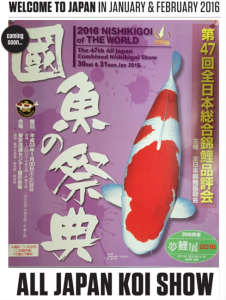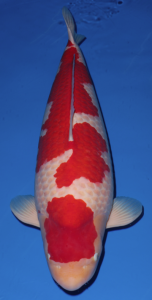With the All Japan Koi Show already in the books (held in late January in Tokyo) and the International Junior Koi Show on the horizon (April 23-24), it is as good a time as any to explore how the finest examples of koi in the hobby are awarded.
To get a good idea on the breadth and depth of koi awards, here’s a look at how the best-known koi show in the world—the All Japan Koi Show—is judged. With entries from around the world that can number over 1,500, the judges—drawn from ZNA-certified hobbiest judges who have had years of training and testing—have their work cut out for them.
Divided by Size
Size really does matter. As a koi grows, generally the more desirable traits become more pronounced. This development is so important in the judging of koi, that there are 17 different size categories that are then divided into groups.
The first division is up to 12cm (4.5in). From there, it goes up to 85cm (33in) with a category of 85cm and over!
After 15cm (6in) a new size grouping is created for every 5cm (2in). Each of these groups, named “bu,” takes the largest measurement in the group ie the 12-15cm group is referred to as 15BU, the 15-20cm group the 20BU. The highest group is 90BU.
Submitting the wrong size is grounds for immediate disqualification.
All koi, regardless of sex, are judged equally until the 55cm (55BU) category when males are placed into their own smaller subset of “male variety” categories and are judged separate from the females.
Here is a chart of the divisions and how they are grouped
|
Baby (Yogyo) |
12BU — up to 12cm 15BU — 12cm up to 15cm 20BU — 15cm up to 20cm 25BU — 20cm up to 25cm |
|
Young |
30BU — 25cm up to 30cm 35BU — 30cm up to 35cm 40BU — 35cm up to 40cm |
| Adult | 45BU — 40cm up to 45cm 50BU — 45cm up to 50cm 55BU — 50cm up to 55cm |
| Mature | 60BU — 55cm up to 60cm 65BU — 60cm up to 65cm 70BU — 65cm up to 70cm |
| Superior | 75BU — 70cm up to 75cm 80BU — 75cm up to 80cm |
| Jumbo | 85BU — 80cm up to 85cm 90BU — over 85cm |
Divided by Variety
To make things even more complicated, each of these size categories have 21 classes of koi within each category.
 These classes are:
These classes are:
- Kohaku
- Taisho Sanke
- Showa Sanshoku
- Shiro Utsuri
- Hikarimuji
- Hikarimoyo
- Asagi
- Shusui
- Kawarigoi
- Goshiki
- A Ginrin (Gosanke)
- B Ginrin (other than A Ginrin)
- Bekko
- Hikari Utsuri
- Tancho
- Koromo
- Doitsu (excluding Shusui, Hikarimono, and Kumonryu)
- Kujaku (including Doitsu Kujaku)
- Kumonryu
- Hi Utsuri / Ki Utsuri
- Mujimono
Submitting the wrong size is grounds for immediate disqualification.
Over the years, the number of classifications used to judge koi in the AJKS has grown from 7 to 21 (with an new classification—Muijimono—being added at the most recent 2016 show) as highlighted in this nishikigoilife post
Once a koi reaches the 55BU category, the males and females are then judged separately. However, the males are judged in a much smaller set of classes (seven in all). They are:
- Kohaku
- Taisho Sanshoku
- Showa Sanshoku, Shiro Utsuri, Ki Utsuri, Hi Utsuri
- A Ginrin (Gosanke)
- Hikari
- Doitsu Koi (excluding Shusui and Hikari)
- Kawarigoi (all others not mentioned specifically above)
Awards
For a casual observer, the awards can be a little daunting. And the fact that at a show the size of the AJKS can have no less than 500 awards, it is can be tough to follow along.
The names on the awards might be slightly different according to the size and location of the show, but the judging criteria and standards that are maintained are very similar—and they are stringent.
Grand Champion
 This is the most coveted prize in the competition and probably in the koi world. It is open to all the koi in the show. Every judge is given a vote and if one koi gets over 50% of the vote it is awarded the prize. If there is no clear cut winner, the top 5 are chosen. This narrowed field is then re-balloted until one receives over 50% of the votes.
This is the most coveted prize in the competition and probably in the koi world. It is open to all the koi in the show. Every judge is given a vote and if one koi gets over 50% of the vote it is awarded the prize. If there is no clear cut winner, the top 5 are chosen. This narrowed field is then re-balloted until one receives over 50% of the votes.
Champions
Every size group and every variety in that group will been awarded a champion. Consider the sheer numbers involved in that. Seventeen size classes and 21 varieties (21×17) plus the seven male categories across 8 sizes (7×8) makes for 413 awards.
Best in Size Awards
Kokugyo
This award is essentially an award for best in size. A koi from each size class (17 + 8 male), regardless of variety, is given this award. The Grand Champion given the overall Kokugo award.
Division Champions
This is another best in size award, except this is drawn from the kokugyo winners who are then judged in their particular divisions. The divisions in consideration are:
- Baby (15bu-25bu)
- Young (30bu-40bu)
- Adult (45bu-55bu)
- Mature—no males (60bu-70bu)
- Superior—no males (75bu-80bu)
- Jumbo—no males (85bu-90bu)
- Mature Male (up to 70bu)
- Superior Male (over 70bu)
Best in Variety Awards
For this award, the best koi in each variety—regardless of size—is recognized. This is an exclusive award, meaning that the Grand Champion is not necessarily given this award automatically. There are 21 awards in all.
Miyabi Award
There are 17 awards given to the best examples of the Gosanke variety classes of koi. It also includes Shiro Utsuri. The best on these awards is then separately dubbed the Miyabi Champion.
Sakura Award
 Paring down the variety awards even more, 17 non-Gosanke koi (one in each size group) is given this award. The Sakura Champion is chosen from the group winners. It excludes the Shiro Utsuri (which are in the Miyabi award pool), but includes:
Paring down the variety awards even more, 17 non-Gosanke koi (one in each size group) is given this award. The Sakura Champion is chosen from the group winners. It excludes the Shiro Utsuri (which are in the Miyabi award pool), but includes:
- Goshiki
- Kawarigoi
- Ginrin A
- Ginrin B
- Kujaku
Tsubaki Award
 Introduced in 2012, awards are given in every size group (17) for each of these five classes. The best of the 5 is then named the Tsubaki Champion:
Introduced in 2012, awards are given in every size group (17) for each of these five classes. The best of the 5 is then named the Tsubaki Champion:
- Hikarimoyo
- Tancho
- Goromo
- Doitsugoi
- Kumonryu
Botan Award
 Another 2012 prize addition, 17 Botan award are given to the best in each size class of the following eight varieties, with the best of the 17 being chosen as Botan Champion:
Another 2012 prize addition, 17 Botan award are given to the best in each size class of the following eight varieties, with the best of the 17 being chosen as Botan Champion:
- Hikarimuji
- Asagi
- Shusui
- Bekko
- Hikariutsuri
- Hi Utsuri
- Ki Utsuri
- Mujimono (a new addition to the show categories that includes single-colour, non-metallic koi—doitsu,too—Chagoi, Karashigoi, Benigoi, Kigoi, Aka Matsuba, Ki Matsuba.)
Jumbo A Miya Hideo Prize
This is an award for the show’s most “full-figured” Gosanke that still has the type of desirable body conformation.
Jumbo B Yoshida Hiroshi Prize
The Jumbo B goes to the largest non-Gosanke at the show.
As you can tell, there are a lot of awards floating around. And that doesn’t include the runners up and honorable mentions either!

